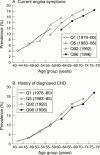Is the prevalence of coronary heart disease falling in British men?
- PMID: 11602539
- PMCID: PMC1729960
- DOI: 10.1136/heart.86.5.499
Is the prevalence of coronary heart disease falling in British men?
Abstract
Objective: To assess whether long term trends over time in acute coronary heart disease (CHD) event rates have influenced the burden of prevalent CHD in British men.
Design: Longitudinal cohort study.
Participants: 7735 men, aged 40-59 at entry (1978-80), selected from 24 British towns.
Methods: The prevalences of current angina symptoms and history of diagnosed CHD were ascertained by questionnaire in 1978-80, 1983-85, 1992, and 1996. New major CHD events (fatal and non-fatal) were ascertained throughout the study from National Health Service central registers and general practice record reviews. Age adjusted trends in CHD prevalence were compared with trends in major CHD event rates.
Results: From 1978-1996 there was a clear decline in the prevalence of current angina symptoms: the age adjusted annual percentage change in odds was -1.8% (95% confidence interval (CI) -2.8% to -0.8%). However, there was no evidence of a trend in the prevalence of history of diagnosed CHD (annual change in odds 0.1%, 95% CI -1.0% to 1.2%). Over the same period, the CHD mortality rate fell substantially (annual change -4.1%, 95% CI -6.5% to -1.6%); rates of non-fatal myocardial infarction, all major CHD events, and first major CHD event fell by -1.7% (95% CI -3.9% to 0.5%), -2.5% (95% CI -4.1% to -0.8%), and -2.4% (95% CI% -4.3 to -0.4%), respectively.
Conclusions: These results suggest that middle aged British men are less likely to experience symptoms of angina than in previous decades but are just as likely to have a history of diagnosed CHD. Despite falling rates of new major events and falling symptom prevalence, the need for secondary prevention among middle aged men with established CHD is as great as ever.
Figures
References
Publication types
MeSH terms
LinkOut - more resources
Full Text Sources


